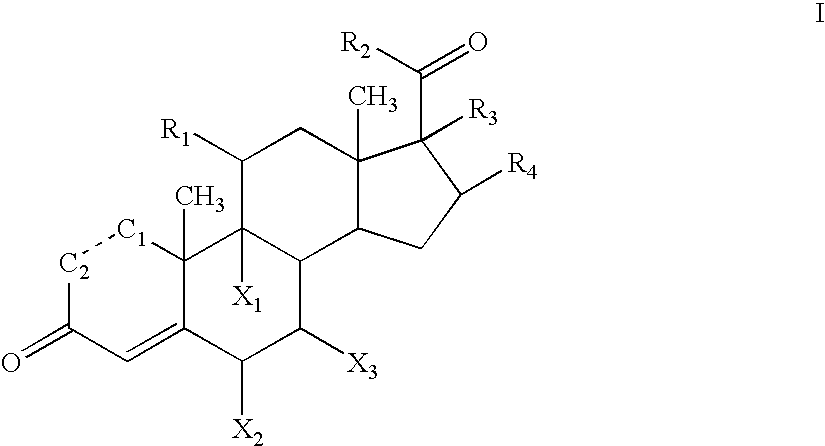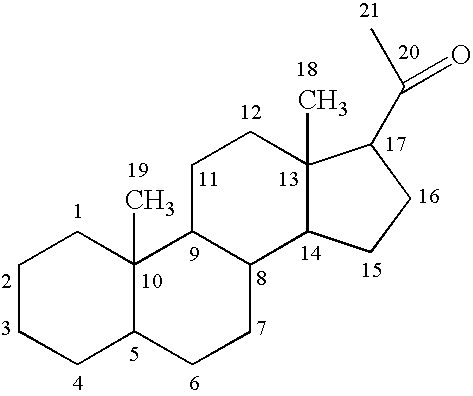Corticosteroid conjugates and uses thereof
a corticosteroid and conjugate technology, applied in the field of corticosteroid conjugates, can solve the problems of brain exposure to corticosteroid without any therapeutic benefit, possible severe adverse effects, etc., and achieve the effect of reducing the occurrence of adverse reactions and reducing activity
- Summary
- Abstract
- Description
- Claims
- Application Information
AI Technical Summary
Benefits of technology
Problems solved by technology
Method used
Image
Examples
example 1
Protection and Deprotection of Reactive Groups
[0087]The synthesis of corticosteroid conjugates may involve the selective protection and deprotection of alcohols, amines, ketones, sulfhydryls or carboxyl functional groups of the corticosteroid, the linker, the bulky group, and / or the charged group. For example, commonly used protecting groups for amines include carbamates, such as tert-butyl, benzyl, 2,2,2-trichloroethyl, 2-trimethylsilylethyl, 9-fluorenylmethyl, allyl, and m-nitrophenyl. Other commonly used protecting groups for amines include amides, such as formamides, acetamides, trifluoroacetamides, sulfonamides, trifluoromethanesulfonyl amides, trimethylsilylethanesulfonamides, and tert-butylsulfonyl amides. Examples of commonly used protecting groups for carboxyls include esters, such as methyl, ethyl, tert-butyl, 9-fluorenylmethyl, 2-(trimethylsilyl)ethoxy methyl, benzyl, diphenylmethyl, O-nitrobenzyl, ortho-esters, and halo-esters. Examples of commonly used protecting groups...
example 2
Preparation of C21 Derivatives of Prednisolone
[0089]21-methanesulfonate prednisolone can be prepared according to the methods described in U.S. Pat. No. 2,932,657. The corresponding amine can be prepared by reaction with potassium phthalimide followed by hydrolysis as described by, for example, J. March, Advanced Organic Chemistry: Reactions, Mechanisms and Structure, John Wiley & Sons, Inc. page 426, 1992. The free amine of the 21-amino prednisolone derivative can be reacted with an activated carboxyl. Carboxyls can be activated, for example, by formation of an active ester, such as nitrophenylesters, N-hydroxysuccinimidyl esters, or others as described in Chem. Soc. Rev. 12:129, 1983 and Angew. Chem. Int. Ed. Engl. 17:569, 1978, incorporated herein by reference. For example, oxalic acid (Aldrich, catalogue number 24, 117-2) can be attached as a linking group, as shown below in reaction 1.
[0090]The protecting group in the reaction product can be removed by hydrolysis. The resulting...
example 3
Preparation of a Polyguanidine Peptoid Derivative of Prednisolone
[0091]The polyguanidine peptoid N-hxg, shown below, can be prepared according to the methods described by Wender et al., Natl Acad Sci USA 97(24):13003-8, 2000, incorporated herein by reference.
[0092]The carboxyl derivative of prednisolone from Example 2 can be activated, vide supra, and conjugated to the protected precursor of N-hxg followed by the formation of the guanidine moieties and cleavage from the solid phase resin, as described by Wender ibid., to produce the polyguanidine prednisolone conjugate shown below.
[0093]In this example, the bulky group has a molecular weight of over 1900 Daltons. Accordingly, in the example above, prednisolone is conjugated to a bulky group containing several positively charged moieties.
PUM
| Property | Measurement | Unit |
|---|---|---|
| alpha-1-acid glycoprotein | aaaaa | aaaaa |
| size | aaaaa | aaaaa |
| swelling | aaaaa | aaaaa |
Abstract
Description
Claims
Application Information
 Login to View More
Login to View More - R&D
- Intellectual Property
- Life Sciences
- Materials
- Tech Scout
- Unparalleled Data Quality
- Higher Quality Content
- 60% Fewer Hallucinations
Browse by: Latest US Patents, China's latest patents, Technical Efficacy Thesaurus, Application Domain, Technology Topic, Popular Technical Reports.
© 2025 PatSnap. All rights reserved.Legal|Privacy policy|Modern Slavery Act Transparency Statement|Sitemap|About US| Contact US: help@patsnap.com



